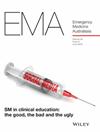Prescription Practises in the Emergency Department of a Tertiary Level Hospital of a Lower-Middle Income Country: Drug Use Indicator Analysis
Abstract
Objective
Emergency departments are constantly overcrowded with patients in lower-middle-income countries (LMICs) like Nepal, where there is a high likelihood of prescription-related problems and deviations from lists of essential medicines. Few studies have reported the prescribing patterns in emergency departments in LMICs like Nepal. The objective of this study was to assess World Health Organization (WHO) core drug use indicators in the emergency department of a tertiary-level teaching hospital.
Methods
This cross-sectional descriptive study was conducted in a tertiary level hospital, assessing 384 prescriptions after obtaining Institutional Review Committee (IRC) permission. A validated proforma was used to collect demographic data, diagnoses, prescriptions, and patient outcomes. The time taken to administer the first drug, total turnaround time, commonly prescribed drug groups with commonly prescribed drugs, and common disease patterns were also recorded.
Results
The average age of a total of 384 patients was 51.58 ± 28.94 years. The average turnaround time was 100.37 ± 3.01 min. Gastrointestinal illnesses (26.37%) were the most prevalent illness, pantoprazole (11.05%) being the most frequently used drug. The average number of drugs per encounter was 2.38, and injections accounted for 86.76%, generic prescribing 18.70%, antibiotics for 8.10%, and 81.73% of the drugs were from the National List of Essential Medicines (NLEM) of Nepal.
Conclusion
This study found a higher average number of drugs per encounter than the WHO optimal value, with 81.73% of prescriptions containing medicines from the NLEM. While the study provides valuable insights into prescribing practises, there is a need to enhance generic prescribing.


 求助内容:
求助内容: 应助结果提醒方式:
应助结果提醒方式:


